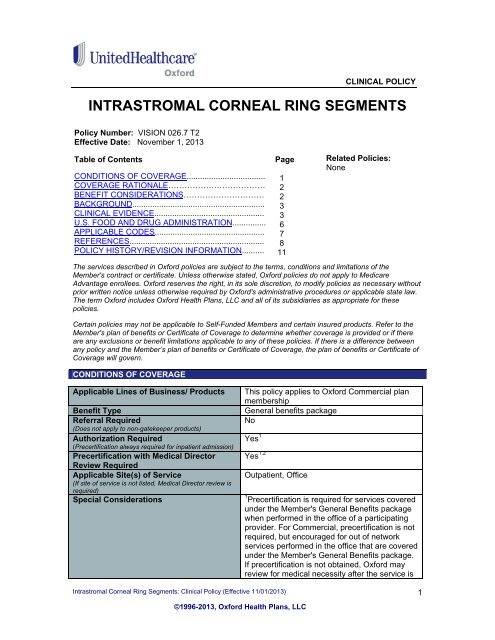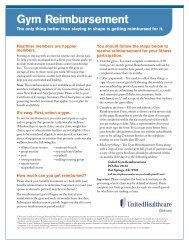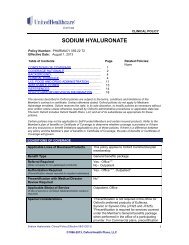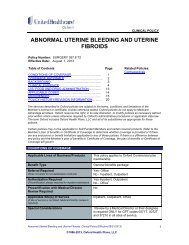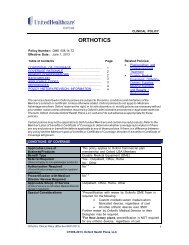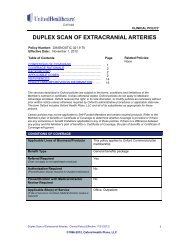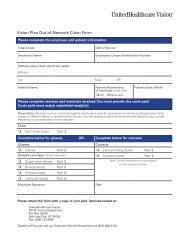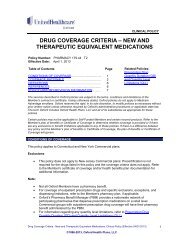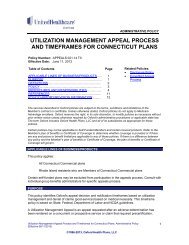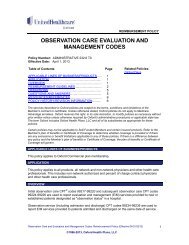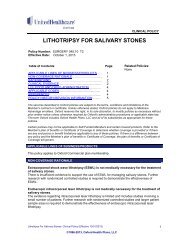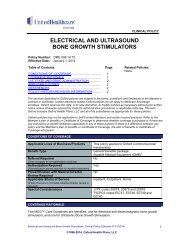INTRASTROMAL CORNEAL RING SEGMENTS - Oxford Health Plans
INTRASTROMAL CORNEAL RING SEGMENTS - Oxford Health Plans
INTRASTROMAL CORNEAL RING SEGMENTS - Oxford Health Plans
You also want an ePaper? Increase the reach of your titles
YUMPU automatically turns print PDFs into web optimized ePapers that Google loves.
CLINICAL POLICY<strong>INTRASTROMAL</strong> <strong>CORNEAL</strong> <strong>RING</strong> <strong>SEGMENTS</strong>Policy Number: VISION 026.7 T2Effective Date: November 1, 2013Table of ContentsCONDITIONS OF COVERAGE...................................COVERAGE RATIONALE………………………………BENEFIT CONSIDERATIONS…………………………BACKGROUND...........................................................CLINICAL EVIDENCE.................................................U.S. FOOD AND DRUG ADMINISTRATION...............APPLICABLE CODES.................................................REFERENCES............................................................POLICY HISTORY/REVISION INFORMATION..........Policy History Revision InformationThe services described in <strong>Oxford</strong> policies are subject to the terms, conditions and limitations of theMember's contract or certificate. Unless otherwise stated, <strong>Oxford</strong> policies do not apply to MedicareAdvantage enrollees. <strong>Oxford</strong> reserves the right, in its sole discretion, to modify policies as necessary withoutprior written notice unless otherwise required by <strong>Oxford</strong>'s administrative procedures or applicable state law.The term <strong>Oxford</strong> includes <strong>Oxford</strong> <strong>Health</strong> <strong>Plans</strong>, LLC and all of its subsidiaries as appropriate for thesepolicies.Certain policies may not be applicable to Self-Funded Members and certain insured products. Refer to theMember's plan of benefits or Certificate of Coverage to determine whether coverage is provided or if thereare any exclusions or benefit limitations applicable to any of these policies. If there is a difference betweenany policy and the Member’s plan of benefits or Certificate of Coverage, the plan of benefits or Certificate ofCoverage will govern.CONDITIONS OF COVERAGEPage1223367811Related Policies:NoneApplicable Lines of Business/ ProductsBenefit TypeReferral Required(Does not apply to non-gatekeeper products)Authorization Required(Precertification always required for inpatient admission)Precertification with Medical DirectorReview RequiredApplicable Site(s) of Service(If site of service is not listed, Medical Director review isrequired)Special ConsiderationsThis policy applies to <strong>Oxford</strong> Commercial planmembershipGeneral benefits packageNoYes 1Yes 1,2Outpatient, Office1 Precertification is required for services coveredunder the Member's General Benefits packagewhen performed in the office of a participatingprovider. For Commercial, precertification is notrequired, but encouraged for out of networkservices performed in the office that are coveredunder the Member's General Benefits package.If precertification is not obtained, <strong>Oxford</strong> mayreview for medical necessity after the service isIntrastromal Corneal Ring Segments: Clinical Policy (Effective 11/01/2013)©1996-2013, <strong>Oxford</strong> <strong>Health</strong> <strong>Plans</strong>, LLC1
Special Considerations(continued)rendered2 Precertification with review by a MedicalDirector or their designee is required.Note: The Enrollee-specific benefit document must be reviewed to determine coverage orexclusions. Some health plans may exclude coverage for surgery related to correcting myopia.Refer to the Member's specific Certificate of Coverage, health benefits plan, and/or summary ofbenefits documentation for additional information.COVERAGE RATIONALEWhen provided according to U.S. Food and Drug Administration (FDA) labeled indications,intrastromal corneal ring segments (ICRS) implantation is medically necessary for visioncorrection of mild myopia. Mild myopia is defined as myopia -1.0 to -3.0 diopters.See also the Benefit Considerations section below. The enrollee-specific benefit document mustbe reviewed to determine coverage or exclusions.Intrastromal corneal ring segments (ICRS) implantation is medically necessary for treatment ofkeratoconus when used according to FDA labeled indications in patients who meet all of thefollowing criteria:• 21 years of age or older,• Progressive deterioration of vision such that patients cannot achieve adequate functionalvision with eyeglasses or contacts,• Clear central cornea,• Corneal thickness of 450 microns or greater at the proposed incision site, and• Corneal transplantation is the only remaining option to improve vision.Intrastromal corneal ring segments (ICRS) implantation is not medically necessary for thefollowing:• Ectasia after laser-assisted in situ keratomileusis (LASIK) or after photorefractivekeratectomy (PRK) and• All other indications not listed above as medically necessary.Clinical trials evaluating ICRS implantation for the correction of other visual conditions areinadequate to establish the safety and efficacy of this procedure. The long-term efficacy of ICRSimplantation for ectasia after LASIK or PRK has not been established in well designed studies.Additional research is needed to establish the role of ICRS implantation for conditions other thanthose described as medically necessary. Intrastromal corneal ring segments are approved by theU.S. Food and Drug Administration (FDA) for mild myopia and keratoconus (as a HumanitarianDevice Exemption). All other conditions such as post-LASIK or post-PRK ectasia are not FDAapproved indications for intrastromal corneal ring segments.BENEFIT CONSIDERATIONSMost Certificates of Coverage (COC) contain an explicit exclusion for vision correction surgery.For example, intrastromal corneal ring segments (ICRS) used to treat myopia or other refractiveerrors may be excluded from coverage, but ICRS to treat keratoconus may be covered under theCOC. The enrollee-specific benefit document must be reviewed to determine coverage orexclusions.BACKGROUNDWhen eyes are misshapen, vision is affected due to refractive error (i.e., myopia, hyperopia orastigmatism) that prevents images from being focused on the retina. For most patients who haverefractive disorders, normal vision can be obtained with corrective aids such as eyeglasses orcontact lenses.Intrastromal Corneal Ring Segments: Clinical Policy (Effective 11/01/2013)©1996-2013, <strong>Oxford</strong> <strong>Health</strong> <strong>Plans</strong>, LLC2
Vision may also be affected by keratoconus, a noninflammatory corneal disorder that affects lessthan 1% of the general population, with onset in the teen and young adult years. Persons withkeratoconus have progressive myopia and astigmatism that develop due to progressive cornealsteepening and thinning. Although the cause of this disorder is unknown, it can usually be treatedsuccessfully with contact lenses. For patients with more severe disease or those who cannottolerate contact lenses, surgery may be indicated. The most common surgery for keratoconus is acorneal transplantation procedure such as penetrating keratoplasty.To avoid the maintenance associated with eyeglasses and contact lenses and to avoid thepotential complications associated with penetrating keratoplasty, a surgical procedure for thetreatment of myopia or keratoconus has been developed. This procedure involves the insertion oftwo thin, clear, semicircular-shaped, plastic intrastromal corneal ring segments (ICRS) into thecornea of an affected eye through a single corneal incision.. ICRS implantation has also beenproposed to restore vision in patients with ectasia (bulging of the cornea caused by complicationsfrom laser-assisted in situ keratomileusis (LASIK) or photorefractive keratectomy (PRK) surgery).At present, the Intacs (R) system is the only FDA-approved ICRS.CLINICAL EVIDENCEMyopia:Schanzlin et al. (2001) conducted the largest available study of intrastromal corneal ringsegments (ICRS) inserts for myopia, a multicenter, uncontrolled study in which 449 patients eachunderwent the procedure in one eye. All eyes had low myopia and at baseline, 87% of eyes hadan uncorrected visual acuity (UCVA) worse than 20/40. Two years after ICRS implantation, 97%of eyes had a UCVA of 20/40 or better and 76% of eyes had a UCVA of 20/20 or better. Thisresult suggests that ICRS inserts improved unaided vision, equal to that which could be achievedwith eyeglasses or contacts. Comparing best-spectacle corrected visual acuity (BSCVA) atbaseline and 2 years follow-up, the only result reported was that 1% of eyes lost 2 lines ofBSCVA. These outcomes at 2 years follow-up did not include the 8% of eyes that underwentinsert removal due to unacceptable visual symptoms, dissatisfaction with visual outcome,infection, or other problems.Holmes-Higgin et al. (2002) performed a retrospective analysis of 263 of the patients enrolled bySchanzlin et al. who had reported adverse postoperative visual symptoms or requested removalof inserts, and found that the only statistically significant correlation with fewer symptoms was amean keratometry greater than 45 diopters at baseline. There were also trends toward fewersymptoms in eyes with the following characteristics: manifest refractive astigmatism of 0.75 to 1.0diopter, UCVA improvement of at least two lines more than predicted, and pretreatment use ofsoft contact lenses. Improved patient selection criteria may result in lower rates of insert removalin future studies.The ability of ICRS inserts to provide equal myopia correction to that provided by eyeglasses orcontacts was confirmed in a small nonrandomized controlled study. Nio et al. (2003) enrolled 28patients with low to moderate myopia and assigned 10 patients to insert implantation while theremaining 18 patients continued to use their eyeglasses or contact lenses. Compared witheyeglasses and contact lenses, ICRS inserts provided equal improvements in BCVA or quality ofvision.The National Institute for <strong>Health</strong> and Clinical Excellence (NICE) issued guidance on the use ofcorneal implants for the correction of refractive error. The guidance for corneal implants forrefractive error states that current evidence shows limited and unpredictable benefit for the use ofthis procedure. Therefore, corneal implants should not be used for the treatment of refractiveerror in the absence of other ocular pathology such as keratoconus (NICE, Corneal implants forthe correction of refractive error, 2007).Professional SocietiesAmerican Academy of Ophthalmology (AAO): A technology assessment performed by theIntrastromal Corneal Ring Segments: Clinical Policy (Effective 11/01/2013)©1996-2013, <strong>Oxford</strong> <strong>Health</strong> <strong>Plans</strong>, LLC3
AAO has concluded that ICRS inserts are reasonably safe and effective for the treatment of mildmyopia (-1.0 to -3.0 diopters) when patients have stable manifest refraction and less than 1diopter of astigmatism. However, the AAO assessment cautions that further research is neededto determine the long-term effectiveness of this procedure as well as its safety and effectivenesscompared with other treatments such as LASIK and photorefractive keratectomy (Rapuano et al.,2001).The AAO's Preferred Practice Pattern for Refractive Errors and Refractive Surgery states thatintrastromal corneal ring segments are now rarely utilized to correct myopia (AAO, 2007).Keratoconus:Guell et al. (2010) reported the 4-year outcomes after Intacs intrastromal corneal ring segment(ICRS) implantation to correct low myopia in patients with abnormal topography in a retrospectiveconsecutive interventional case series. After ICRS implantation, 82.05% of 39 eyes (21 patients)were within ±1.00 diopter (D) of emmetropia and 46.15% were within ±0.50 D. Refractivecorrection improved during the first 6 months and remained stable up to 4 years. Theinvestigators concluded that 4-year results indicate that ICRS implantation is effective and safe inthe correction of low myopia in patients for whom excimer laser surgery is contraindicatedbecause of abnormal topography, including forme fruste keratoconus. The achieved refractivecorrection remained stable throughout the follow-up.Hellstedt et al. (2005) treated 50 eyes (37 patients) with Intacs and reported that asymmetricIntacs placement improves BSCVA and UCVA and reduces astigmatism in patients with mild tomoderate keratoconus. The authors reported that the procedure is safe and effective and that thechange in astigmatism correction is unpredictable.Colin and Malet (2007) evaluated the use of Intacs in 100 keratoconic eyes 2 years after Intacsplacement. Removal of the segments occurred in 2 eyes due to extrusion and 2 eyes due to poorvisual outcome. At 2 years, of the 82 eyes available for follow-up, UCVA and BCVA improved in80.5% and 68.3% of the eyes, respectively. The investigators concluded that significant andsustained improvements in objective visual outcomes were achieved in most patients.A nonrandomized comparative study and analysis of retrospective data included 17 patients withkeratoconus who had penetrating keratoplasty (PKP) in 1 eye and Intacs implantation in the othereye. Follow-up after PKP was at 24 hours and 6 and 24 months and after Intacs implantation, at24 hours and 3 and 10 months. UCVA and BCVA improved in both groups. No patient lost a lineof acuity. Eyes with Intacs had a shorter recovery time than eyes having PKP. The eyes withIntacs had no complications. Complications in eyes with PKP included cataract, graft rejection,and elevated intraocular pressure. The investigators concluded that Intacs may delay or preventthe need for a corneal graft, although more research with longer follow-up is needed (Rodriguezet al., 2007).Several studies evaluated the use of the Ferrara intrastromal corneal ring (Pesando 2010,Torquetti et al. 2009, Ferrara and Torquietti 2009, Kwitko and Severo, 2004; Ferrara et al. 2011)and the Keraring (de Freitas et al. 2010) for keratoconus. The Ferrara intrastromal corneal ringand the Keraring are not currently approved by the U.S. Food and Drug Administration (FDA).The National Institute for <strong>Health</strong> and Clinical Excellence (NICE) issued guidance on the use ofcorneal implants for keratoconus. The NICE guidance states that current evidence on the safetyand efficacy of corneal implants for keratoconus appears adequate to support the use of thisprocedure (NICE, Corneal implants for keratoconus, 2007).Post-Laser-Assisted In Situ Keratomileusis (LASIK) or Post- Photorefractive Keratectomy(PRK) Ectasia:Intrastromal corneal ring segments have been investigated as a treatment for ectasia after LASIKor PRK. Although early results show potential (Kymionis et al. 2003: n=10 eyes and 1 year followup,Alio et al. 2002: 3 eyes and mean follow-up of 8.3 months, Lovisolo et al. 2002: 4 eyes and 12Intrastromal Corneal Ring Segments: Clinical Policy (Effective 11/01/2013)©1996-2013, <strong>Oxford</strong> <strong>Health</strong> <strong>Plans</strong>, LLC4
to 44 months follow-up, Pokroy et al. 2004: 5 eyes and 9 month follow-up, Siganos et al. 2002: 3eyes and mean follow-up of 8.7 months, Rodríguez et al. 2009: n=7 eyes and 9 monthpostoperative follow-up; Kymionis et al. 2010: 2 patients and 12 month follow-up), the long-termefficacy for this procedure has not been established. Limitations of these studies included smallsample sizes, absence of controlled groups, and short follow-up.Tunc et al. (2011) evaluated the clinical outcomes of intracorneal ring segments (ICRS) (Keraringsegment implantation) in 12 eyes of 10 patients with post- laser-assisted in situ keratomileusis(LASIK) ectasia. The mean preoperative uncorrected distance visual acuity (UDVA) for all eyeswas 1.28 ± 0.59 logarithm of the Minimum Angle of Resolution (logMAR). At 12 months, the meanUDVA was 0.36 ± 0.19 logMAR, and the mean preoperative corrected distance visual acuity(CDVA) was 0.58 ± 0.3 logMAR, which improved to 0.15 ± 0.12 at 1 year. No significant changesin mean central corneal thickness were observed postoperatively and there were no majorcomplications during or after surgery. The authors concluded the ICRS implantation using aunique mechanical dissection technique is a safe and effective treatment for post-LASIK ectasia.According to the authors, study limitations included small sample of treated eyes, the lack ofhigher-order aberration analysis, and the lack of a comparative group.Pinero et al. (2010) evaluated and compared visual, refractive, and corneal aberrometricoutcomes after implantation of 2 types of intrastromal corneal ring segments (ICRS) in eyes withearly to moderate ectatic disease in a retrospective analysis over a 6 month follow-up. The studyincluded consecutive eyes with grade I or grade II corneal ectasia (keratoconus, pellucid marginaldegeneration, ectasia after laser in situ keratomileusis) that had Intacs (Group I) or KeraRings(Group K) ICRS implantation using femtosecond technology. Group I had 17 eyes and Group K,20 eyes. One month postoperatively, there was a statistically significant reduction in sphere inboth groups. At 6 months, there was a statistically significant reduction in manifest cylinder inGroup K that was consistent with the significant reduction in corneal astigmatic aberration. Theuncorrected distance visual acuity increased significantly in Group K but not in Group I; 41.18% ofeyes in Group I and 52.94% in Group K gained 1 or more lines of corrected distance visual acuity.Both groups had significant corneal flattening. At 1 month, the mean primary spherical aberrationwas 0.17 microm ± 0.52 (SD) in Group I and 0.40 ± 0.35 microm in Group K; the difference wasstatistically significant. The investigators concluded that astigmatism correction in early tomoderate ectatic corneas was more limited with the Intacs ICRS, which induced negative primaryspherical aberration in the initial postoperative period. This study is limited by short-term followup.Torquetti and Ferrara (2010) evaluated the clinical outcomes of implantation of Ferraraintrastromal corneal ring segments (ICRS) in patients with corneal ectasia after refractive surgery.Charts of patients with corneal ectasia after refractive surgery were retrospectively reviewed.Twenty-five eyes (20 patients) with corneal ectasia (20 after laser in situ keratomileusis, 4 afterradial keratotomy, 1 after photorefractive keratectomy) were evaluated. Postoperatively, the meanuncorrected distance visual acuity (UDVA) increased from 20/185 to 20/66 and the meancorrected distance visual acuity (CDVA), from 20/125 to 20/40. The investigators concluded thatintrastromal corneal ring segment implantation significantly improved UDVA and CDVA inpatients with corneal ectasia. The short-term follow-up in this study did not allow for assessmentof intermediate and long-term outcomes.Kymionis et al. (2006) reported on the long-term follow-up (5 years) of Intacs for the managementof post-LASIK corneal ectasia in 8 eyes of 5 patients. Refractive stability was maintained for up to5 years in the treatment of post-LASIK corneal ectasia after Intacs implantation. There was noevidence of progressive time-dependent corneal ectasia, late regression, or sight-threateningcomplications in this study. The limitation of this study was its small sample size.Pinero et al. (2009) evaluated the refractive and aberrometric changes in corneas with post-LASIK keratectasia implanted with intracorneal ring segments (ICRS) during a 2-year follow-up ina retrospective, consecutive case series of 25 patients (34 eyes). Uncorrected visual acuity didnot improve after surgery. Best spectacle-corrected visual acuity increased significantly at 6months. Thirty-nine percent of eyes gained 2 or more lines of best spectacle-corrected visualIntrastromal Corneal Ring Segments: Clinical Policy (Effective 11/01/2013)©1996-2013, <strong>Oxford</strong> <strong>Health</strong> <strong>Plans</strong>, LLC5
acuity (BSCVA) at 6 months, and this percentage increased to 60% at 24 months. There was anonsignificant reduction of sphere at 6 months. Segment ring explantation was performed in 6eyes, and ring reposition was performed in 2 eyes. The apical curvature gradient was significantlyhigher in the group of explanted eyes. The investigators concluded that intracorneal ring segmentimplantation is a useful option for the treatment of coma-like aberrations and astigmatism in post-LASIK corneal ectasia. These findings require confirmation in a larger study. The retrospectivenature of this study limits its validity.Professional SocietiesAmerican Academy of Ophthalmology (AAO): The AAO's Preferred Practice Pattern forRefractive Errors and Refractive Surgery states that management options for ectasia after laserassistedin situ keratomileusis (LASIK) include IOP reduction, rigid contact lenses, andintrastromal corneal ring segments. According to the AAO, intrastromal corneal ring segments(ICRS) are FDA-approved for use in keratoconus. Some favorable but limited results have beenreported when used off-label for ectasia after LASIK. The AAO states that although early resultsshow potential, long-term efficacy for this procedure remains to be determined (AAO, 2007).Other Conditions:Intrastromal corneal ring segment implantation has been investigated for other conditionsincluding pellucid marginal corneal degeneration (Kubaloglu, 2010: n=16 eyes; Ertan andBahadir, 2006: n=9 eyes; Mularoni, 2005: n=8 eyes) or high astigmatism after penetratingkeratoplasty (Arriola-Villalobos, 2009). However, because of limited studies, small sample sizesand weak study designs, there is insufficient data to conclude that intrastromal corneal ringsegment implantation is safe and/or effective for treating these indications. Further clinical trialsdemonstrating the clinical usefulness of this procedure are necessary before it can be consideredproven for these conditions.In a prospective randomized study, Birnbaum et al. (2011) evaluated the efficacy and safety of anintrastromal corneal ring after penetrating keratoplasty. The study included 20 patients, 10 ofwhom received an intracorneal ring (group 1) and 10 who did not (group 2 or control group).Mean follow-up time was 27.6 ± 5.3 months. Mean astigmatism (Orbscan) was 4.4 diopters ingroup 1 and 4.4 diopters in group 2. Spontaneous suture rupture occurred in 5 patients withcorneal ring but in none of the patients in the control group. Three immune reactions wereobserved in 3 patients with corneal ring, whereas group 2 experienced no rejection. The authorsconcluded that the use of the intrastromal corneal ring after penetrating keratoplasty caused noreduction in postoperative astigmatism. According to the authors, its use was significantlyassociated with adverse events.U.S. FOOD AND DRUG ADMINISTRATION (FDA)The Intacs intrastromal corneal ring system is regulated by the FDA as a Class III device that issubject to the most extensive regulations enforced by the FDA via the premarket approvalprocess. The 1999 approval letter for Intacs inserts limits its use to patients with myopia of -1.0 to-3.0 diopters who are at least 21 years of age with an astigmatic component of no more than +1.0diopter and with stable refraction as shown by a change of no more than 0.5 diopter in thepreceding year. See the following Web site for more information:http://www.accessdata.fda.gov/cdrh_docs/pdf/P980031b.pdf. Accessed October 2012.In 2004, the FDA issued a humanitarian device exemption (HDE) approving Intacs implantationfor the reduction or elimination of myopia and astigmatism in patients with keratoconus in patientswho meet the following criteria: at least 21 years of age, progressive deterioration of vision,inadequate vision correction with eyeglasses or contacts, clear central cornea, corneal thicknessof 450 microns or greater at the proposed incision site, and corneal transplantation is the onlyoption other than Intacs to improve vision. See the following Web site for more information:http://www.accessdata.fda.gov/cdrh_docs/pdf4/h040002a.pdf. Accessed October 2012.HDE is a special regulatory marketing approval that makes the device available on a limited basisprovided that: (1) The device is to be used to treat or diagnose a disease or condition that affectsIntrastromal Corneal Ring Segments: Clinical Policy (Effective 11/01/2013)©1996-2013, <strong>Oxford</strong> <strong>Health</strong> <strong>Plans</strong>, LLC6
fewer than 4,000 individuals in the United States; (2) the device would not be available to aperson with such a disease or condition unless the exemption is granted; (3) no comparabledevice (other than a device that has been granted such an exemption) is available to treat ordiagnose the disease or condition; and (4) the device will not expose patients to an unreasonableor significant risk of illness or injury, and the probable benefit to health from using the deviceoutweighs the risk of injury or illness from its use, taking into account the probable risks andbenefits of currently available devices or alternative forms of treatment.Humanitarian use devices may only be used in facilities that have obtained an institutional reviewboard (IRB) approval to oversee the usage of the device in the facility, and after an IRB hasapproved the use of the device to treat or diagnose the specific rare disease. Additionalinformation may be obtained directly from the U.S. Food and Drug Administration (FDA) [Website]- Center for Devices and Radiological <strong>Health</strong> (CDRH) at:http://www.accessdata.fda.gov/scripts/cdrh/cfdocs/cfHDE/HDEInformation.cfm. AccessedOctober 2012The FDA issued the following precautions in conjunction with its 1999 approval order for Intacsinserts: (See the following Web site for more information:http://www.accessdata.fda.gov/cdrh_docs/pdf/P980031b.pdf. Accessed October 2012.Patients treated with the 0.35-mm insert may have worse outcomes than those treated with 0.25-or 0.30-mm inserts.• Overcorrection is more likely for patients with -1.0 diopter myopia.• Intacs inserts may have long-term effects on endothelial cell density but this has not beendetermined.• Intacs implantation causes a temporary decrease in corneal sensation for some patients,although this effect does not seem to be clinically significant.• Patients are predisposed to low-light visual symptoms if they have dilated pupil diameters7.0 mm.• Patients may experience some loss of contrast sensitivity in low-light conditions.• The efficacy and safety of other procedures to modify refraction have not beenestablished for patients who have undergone Intacs implantation and removal.In addition to the precautions listed above, Intacs implantation is contraindicated under thefollowing circumstances: use of Accutane®(isotretinoin), Cordarone® (amiodarone) or Imitrex®(sumatriptan), recurrent corneal erosion syndrome, corneal dystrophy, or other ocular disordersthat might cause complications in the future; and known autoimmune, immunodeficiency, orcollagen vascular disease. Intacs implantation is not recommended for patients who havesystemic diseases that can affect wound healing or for patients who have had ocular Herpessimplex or Herpes Zoster infections. See the following Web site for more information:http://www.accessdata.fda.gov/cdrh_docs/pdf/P980031b.pdf. Accessed October2012.APPLICABLE CODESThe codes listed in this policy are for reference purposes only. Listing of a service or device codein this policy does not imply that the service described by this code is a covered or non-coveredhealth service. Coverage is determined by the Member’s plan of benefits or Certificate ofCoverage. This list of codes may not be all inclusive.Applicable CPT CodesCPT ® Code0099TDescriptionImplantation of intrastromal corneal ring segmentsCPT ® is a registered trademark of the American Medical Association.Intrastromal Corneal Ring Segments: Clinical Policy (Effective 11/01/2013)©1996-2013, <strong>Oxford</strong> <strong>Health</strong> <strong>Plans</strong>, LLC7
REFERENCESThe foregoing <strong>Oxford</strong> policy has been adapted from an existing United<strong>Health</strong>care national policythat was researched, developed and approved by United<strong>Health</strong>care Medical TechnologyAssessment Committee. [2012T0486H]Alio JL, Artola A, Hassanein A, et al. One or 2 Intacs segments for the correction of keratoconus.J Cataract Refract Surg. 2005 May;31(5):943-53.Alio J, Salem T, Artola A, Osman A. Intracorneal rings to correct corneal ectasia after laser in situkeratomileusis. J Cataract Refract Surg 2002;28:1568-74.Alio JL, Shabayek MH, Belda JI, et al. Analysis of results related to good and bad outcomes ofIntacs implantation for keratoconus correction. J Cataract Refract Surg. 2006 May;32(5):756-61.American Academy of Ophthalmology. Preferred Practice Pattern. Refractive Errors & RefractiveSurgery. September 2007. Available at: http://one.aao.org/. Accessed October 2012.Arriola-Villalobos P, Díaz-Valle D, Güell JL et al. Intrastromal corneal ring segment implantationfor high astigmatism after penetrating keratoplasty. J Cataract Refract Surg. 2009Nov;35(11):1878-84.Birnbaum F, Schwartzkopff J, Böhringer D, et al. The intrastromal corneal ring in penetratingkeratoplasty-long-term results of a prospective randomized study. Cornea. 2011 Jul;30(7):780-3.Colin J, Malet FJ. Intacs for the correction of keratoconus: two-year follow-up. J Cataract RefractSurg. 2007 Jan;33(1):69-74.Coscarelli S, Ferrara G, Alfonso JF, et al. Intrastromal corneal ring segment implantation tocorrect astigmatism after penetrating keratoplasty. J Cataract Refract Surg. 2012 Jun;38(6):1006-13.de Freitas Santos Paranhos J, Avila MP, Paranhos A Jr, Schor P. Evaluation of the impact ofintracorneal ring segments implantation on the quality of life of patients with keratoconus usingthe NEI-RQL (National Eye Institute Refractive Error Quality of life) instrument. Br J Ophthalmol.2010 Jan;94(1):101-5.ECRI. Custom Hotline Response. Intrastromal Corneal Ring Segments (Intacs PrescriptionInserts) for Keratoconus: December 2009.ECRI. Custom Hotline Response. Intrastromal Corneal Ring segments (Intacs PrescriptionInserts) for Refractive Errors: October 2008.Ertan A, Bahadir M. Intrastromal ring segment insertion using a femtosecond laser to correctpellucid marginal corneal degeneration. J Cataract Refract Surg. 2006 Oct;32(10):1710-6.Ferrara P, Torquetti L. Clinical outcomes after implantation of a new intrastromal corneal ring witha 210-degree arc length. J Cataract Refract Surg. 2009 Sep;35(9):1604-8.Ferrara G, Torquetti L, Ferrara P, et al. Intrastromal corneal ring segments: visual outcomes froma large case series. Clin Experiment Ophthalmol. 2011 Sep 8. doi: 10.1111/j.1442-9071.2011.02698.x.Ferrara G, Torquetti L, Ferrara P, et al. Intrastromal corneal ring segments: visual outcomes froma large case series. Clin Experiment Ophthalmol. 2012 Jul;40(5):433-9. doi: 10.1111/j.1442-9071.2011.02698.x.Intrastromal Corneal Ring Segments: Clinical Policy (Effective 11/01/2013)©1996-2013, <strong>Oxford</strong> <strong>Health</strong> <strong>Plans</strong>, LLC8
Güell JL, Morral M, Salinas C, et al. Intrastromal corneal ring segments to correct low myopia ineyes with irregular or abnormal topography including forme fruste keratoconus: 4-year follow-up.J Cataract Refract Surg. 2010 Jul;36(7):1149-55.Haddad W, Fadlallah A, Dirani A, et al. Comparison of 2 types of intrastromal corneal ringsegments for keratoconus. J Cataract Refract Surg. 2012 Jul;38(7):1214-21.Hayes Inc. Hayes Directory. Intacs for the Treatment of Keratoconus. December 2012.Hellstedt T, MJ, Uusitalo R, Emre S, Uusitalo R. Treating keratoconus with intacs corneal ringsegments. J Refract Surg. 2005 May-Jun;21(3):236-46.Holmes-Higgin DK, Burris TE, Lapidus JA, Greenlick MR. Risk factors for self-reported visualsymptoms with Intacs inserts for myopia. Ophthalmology. 2002;109(1):46-56.Kanellopoulos AJ, Pe LH, Perry HD, Donnenfeld ED. Modified intracorneal ring segmentimplantations (INTACS) for the management of moderate to advanced keratoconus: efficacy andcomplications. Cornea. 2006 Jan;25(1):29-33.Kwitko S, Severo NS. Ferrara intracorneal ring segments for keratoconus. J Cataract RefractSurg. 2004 Apr;30(4):812-20.Kymionis GD, Bouzoukis DI, Portaliou DM, et al. New INTACS SK implantation in patients withpost-laser in situ keratomileusis corneal ectasia. Cornea. 2010 Feb;29(2):214-6.Kymionis GD, Siganos CS, Kounis G, et al. Management of post-LASIK corneal ectasia withIntacs inserts: one-year results. Arch Ophthalmol 2003;121:322-6.Kymionis GD, Tsiklis NS, Pallikaris AI, et al. Long-term follow-up of Intacs for post-LASIK cornealectasia. Ophthalmology. 2006 Nov;113(11):1909-17.Levinger S, Pokroy R. Keratoconus managed with intacs: one-year results. Arch Ophthalmol.2005 Oct;123(10):1308-14.Lovisolo CF, Fleming JF. Intracorneal ring segments for iatrogenic keratectasia after laser in situkeratomileusis or photorefractive keratectomy. J Refract Surg 2002;18:535-41.Mularoni A, Torreggiani A, di Biase A et al. Conservative treatment of early and moderate pellucidmarginal degeneration: a new refractive approach with intracorneal rings. Ophthalmology. 2005Apr;112(4):660-6.National Institute for <strong>Health</strong> and Clinical Excellence (NICE).Guidance for Corneal implants forkeratoconus. July 2007. Available at: http://www.nice.org.uk/nicemedia/pdf/IPG227guidance.pdf.Accessed October 2012.National Institute for <strong>Health</strong> and Clinical Excellence (NICE). Guidance for Corneal implants for thecorrection of refractive error. July 2007. Available at:http://www.nice.org.uk/nicemedia/pdf/IPG225Guidance.pdf. Accessed October 2012.Nio YK, Jansonius NM, Wijdh RH, et al. Effect of methods of myopia correction on visual acuity,contrast sensitivity, and depth of focus. J Cataract Refract Surg. 2003;29(11):2082-2095.Pesando PM, Ghiringhello MP, Di Meglio G, et al. Treatment of keratoconus with Ferrara ICRSand consideration of the efficacy of the Ferrara nomogram in a 5-year follow-up. Eur JOphthalmol. 2010 Sep-Oct;20(5):865-73.Intrastromal Corneal Ring Segments: Clinical Policy (Effective 11/01/2013)©1996-2013, <strong>Oxford</strong> <strong>Health</strong> <strong>Plans</strong>, LLC9
Pinero DP, Alió JL, El Kady B, et al. Corneal aberrometric and refractive performance of 2intrastromal corneal ring segment models in early and moderate ectatic disease. J CataractRefract Surg. 2010 Jan;36(1):102-9.Pinero DP, Alio JL, Morbelli H, et al. Refractive and corneal aberrometric changes afterintracorneal ring implantation in corneas with pellucid marginal degeneration. Ophthalmology.2009 Sep;116(9):1656-64.Pinero DP, Alio JL, Uceda-Montanes A, El Kady B, Pascual I. Intracorneal ring segmentimplantation in corneas with post-laser in situ keratomileusis keratectasia. Ophthalmology. 2009Sep;116(9):1665-74.Pokroy R, Levinger S, Hirsh A. Single Intacs segment for post-laser in situ keratomileusiskeratectasia. J Cataract Refract Surg 2004;30:1685-95.Rapuano CJ, Sugar A, Koch DD, et al. Intrastromal corneal ring segments for low myopia: areport by the American Academy of Ophthalmology. Ophthalmology. 2001;108(10):1922-1928.Rodriguez, LA, Guillen, PB, Benavides, MA, Garcia, L, Porras, D, and qui-Garay, RM.Penetrating keratoplasty versus intrastromal corneal ring segments to correct bilateral cornealectasia: preliminary study. J Cataract Refract Surg. 2007;33(3):488-496.Rodríguez LA, Villegas AE, Porras D, Benavides MA, Molina J. Treatment of Six Cases ofAdvanced Ectasia After LASIK with 6-mm Intacs SK. J Refract Surg. 2009 Sep 2:1-4. doi:10.3928/1081597X-20090814-04.Ruckhofer J, Stoiber J, Alzner E, Grabner G; Multicenter European Corneal CorrectionAssessment Study Group. One year results of European Multicenter Study of intrastromal cornealring segments. Part 2: complications, visual symptoms, and patient satisfaction. J CataractRefract Surg. 2001;27(2):287-296.Schanzlin DJ, Abbott RL, Asbell PA, et al. Two-year outcomes of intrastromal corneal ringsegments for the correction of myopia. Ophthalmology. 2001;108(9):1688-1694.Schwartz AR, Tinio BO, Esmail F, Babayan A, Naikoo HN, Asbell PA. Ten-year follow-up of 360degrees intrastromal corneal rings for myopia. J Refract Surg. 2006 Nov;22(9):878-83.Sharma M, Boxer Wachler BS. Comparison of single-segment and double-segment Intacs forkeratoconus and post-LASIK ectasia. Am J Ophthalmol. 2006 May;141(5):891-5.Siganos CS, Kymionis GD, Astyrakakis N, et al. Management of corneal ectasia after laser in situkeratomileusis with INTACS. J Refract Surg 2002;18:43-6.Suiter BG, Twa MD, Ruckhofer J, Schanzlin DJ. A comparison of visual acuity, predictability, andvisual function outcomes after intracorneal ring segments and laser in situ keratomileusis. TransAm Ophthalmol Soc. 2000;98:51-57.Torquetti L, Berbel RF, Ferrara P. Long-term follow-up of intrastromal corneal ring segments inkeratoconus. J Cataract Refract Surg. 2009 Oct;35(10):1768-73.Torquetti L, Ferrara P. Intrastromal corneal ring segment implantation for ectasia after refractivesurgery. J Cataract Refract Surg. 2010 Jun;36(6):986-90.Tunc Z, Helvacioglu F, Sencan S. Evaluation of intrastromal corneal ring segments for treatmentof post-LASIK ectasia patients with a mechanical implantation technique. Indian J Ophthalmol.2011 Nov-Dec;59(6):437-43.Intrastromal Corneal Ring Segments: Clinical Policy (Effective 11/01/2013)©1996-2013, <strong>Oxford</strong> <strong>Health</strong> <strong>Plans</strong>, LLC10
Twa MD, Ruckhofer J, Shanzlin DJ. Surgically induced astigmatism after implantation of intacsintrastromal corneal ring segments. J Cataract Refract Surg. 2001;27(3):411-415.POLICY HISTORY/REVISION INFORMATIONDate11/01/2013Action/Description• Removed list of applicable ICD-9 and ICD-10 diagnosis codes(previously included for informational purposes only); no changeto coverage rationale• Archived previous policy version VISION 026.6Intrastromal Corneal Ring Segments: Clinical Policy (Effective 11/01/2013)©1996-2013, <strong>Oxford</strong> <strong>Health</strong> <strong>Plans</strong>, LLC11


